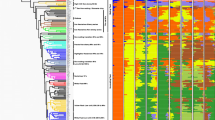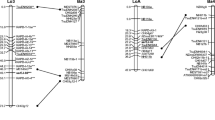Abstract
A genetic linkage map of peach [Prunus persica (L.) Batch] was constructed in order to identify molecular markers linked to economically important agronomic traits that would be particularly useful for long-lived perennial species. An intraspecific F2 population was generated from self-pollinating a single F1 plant from a cross between a flat non-acid peach, ‘Ferjalou Jalousia®’ and an acid round nectarine ‘Fantasia’. Mendelian segregations were observed for 270 markers including four agronomic characters (peach/nectarine, flat/round fruit, acid/non-acid fruit, and pollen sterility) and 1 isoenzyme, 50 RFLP, 92 RAPD, 8 inter-microsatellite amplification (IMA), and 115 amplified fragment length polymorphism (AFLP) markers. Two hundred and forty-nine markers were mapped to 11 linkage groups covering 712 centiMorgans (cM). The average density between pairs of markers is 4.5 cM. For the four agronomic characters studied, molecular markers were identified. This map will be used for the detection of QTL controlling fruit quality in peach and, particularly, the acid and sugar content.
Similar content being viewed by others
Author information
Authors and Affiliations
Additional information
Received: 1 November 1997 / Accepted: 31 March 1998
Rights and permissions
About this article
Cite this article
Dirlewanger, E., Pronier, V., Parvery, C. et al. Genetic linkage map of peach [Prunus persica (L.) Batsch] using morphological and molecular markers. Theor Appl Genet 97, 888–895 (1998). https://doi.org/10.1007/s001220050969
Issue Date:
DOI: https://doi.org/10.1007/s001220050969




